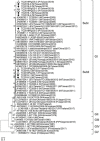The feasibility of field collected pig oronasal secretions as specimens for the virologic surveillance of Japanese encephalitis virus
- PMID: 34860839
- PMCID: PMC8673640
- DOI: 10.1371/journal.pntd.0009977
The feasibility of field collected pig oronasal secretions as specimens for the virologic surveillance of Japanese encephalitis virus
Abstract
Virologic surveillance of Japanese encephalitis virus (JEV) relies on collecting pig blood specimens and adult mosquitoes in the past. Viral RNAs extracted from pig blood specimens suffer from low detecting positivity by reverse transcription PCR (RT-PCR). The oronasal transmission of the virus has been demonstrated in experimentally infected pigs. This observation suggested oronasal specimens could be useful source in the virus surveillance. However, the role of this unusual route of transmission remains unproven in the operational pig farm. In this study, we explore the feasibility of using pig oronasal secretions collected by chewing ropes to improve the positivity of detection in commercial pig farms. The multiplex genotype-specific RT-PCR was used in this study to determine and compare the positivity of detecting JEV viral RNAs in pig's oronasal secretions and blood specimens, and the primary mosquito vector. Oronasal specimens had the overall positive rate of 6.0% (95% CI 1.3%-16.6%) (3/50) to 10.0% (95% CI 2.1%-26.5%) (3/30) for JEV during transmission period despite the negative results of all blood-derived specimens (n = 2442). Interestingly, pig oronasal secretions and female Culex tritaeniorhynchus mosquito samples collected from the same pig farm showed similar viral RNA positive rates, 10.0% (95% CI 2.1%-26.5%) (3/30) and 8.9% (95% CI 2.5%-21.2%) (4/45), respectively (p> 0.05). Pig oronasal secretion-based surveillance revealed the seasonality of viral activity and identified closely related genotype I virus derived from the mosquito isolates. This finding indicates oronasal secretion-based RT-PCR assay can be a non-invasive, alternative method of implementing JEV surveillance in the epidemic area prior to the circulation of virus-positive mosquitoes.
Conflict of interest statement
The authors have declared that no competing interests exist.
Figures



Similar articles
-
Molecular epidemiology of Japanese encephalitis virus in mosquitoes in Taiwan during 2005-2012.PLoS Negl Trop Dis. 2014 Oct 2;8(10):e3122. doi: 10.1371/journal.pntd.0003122. eCollection 2014 Oct. PLoS Negl Trop Dis. 2014. PMID: 25275652 Free PMC article.
-
Japanese Encephalitis Virus Infection among Wild Caught Vectors Mosquitoes and Domestic Pigs in Northern West Bengal, India.Indian J Public Health. 2023 Oct 1;67(4):646-653. doi: 10.4103/ijph.ijph_1734_22. Epub 2023 Dec 29. Indian J Public Health. 2023. PMID: 38934834
-
Targeting of the Nasal Mucosa by Japanese Encephalitis Virus for Non-Vector-Borne Transmission.J Virol. 2018 Nov 27;92(24):e01091-18. doi: 10.1128/JVI.01091-18. Print 2018 Dec 15. J Virol. 2018. PMID: 30282716 Free PMC article.
-
Review of climate, landscape, and viral genetics as drivers of the Japanese encephalitis virus ecology.PLoS Negl Trop Dis. 2013 Sep 12;7(9):e2208. doi: 10.1371/journal.pntd.0002208. eCollection 2013. PLoS Negl Trop Dis. 2013. PMID: 24069463 Free PMC article. Review.
-
The Emergence of Japanese Encephalitis Virus in Australia in 2022: Existing Knowledge of Mosquito Vectors.Viruses. 2022 Jun 2;14(6):1208. doi: 10.3390/v14061208. Viruses. 2022. PMID: 35746679 Free PMC article. Review.
Cited by
-
The alarming spread of Japanese encephalitis: A growing public health concern.Open Vet J. 2025 Apr;15(4):1505-1519. doi: 10.5455/OVJ.2025.v15.i4.1. Epub 2025 Apr 30. Open Vet J. 2025. PMID: 40453861 Free PMC article. Review.
-
Japanese Encephalitis Virus: An Update on the Potential Antivirals and Vaccines.Vaccines (Basel). 2023 Mar 27;11(4):742. doi: 10.3390/vaccines11040742. Vaccines (Basel). 2023. PMID: 37112654 Free PMC article. Review.
-
Genetic Characterization of Japanese Encephalitis Virus Isolates Circulating in Mosquitoes from Pig and Sheep Farms in Shanghai, China.Animals (Basel). 2024 Dec 18;14(24):3653. doi: 10.3390/ani14243653. Animals (Basel). 2024. PMID: 39765557 Free PMC article.
-
Sheep serve as amplifying hosts of Japanese encephalitis virus, increasing the risk of human infection.Sci Adv. 2025 May 16;11(20):eads7441. doi: 10.1126/sciadv.ads7441. Epub 2025 May 16. Sci Adv. 2025. PMID: 40378218 Free PMC article.
-
Re-Examining the Importance of Pigs in the Transmission of Japanese Encephalitis Virus.Pathogens. 2022 May 13;11(5):575. doi: 10.3390/pathogens11050575. Pathogens. 2022. PMID: 35631096 Free PMC article. Review.
References
Publication types
MeSH terms
Substances
LinkOut - more resources
Full Text Sources
Miscellaneous

